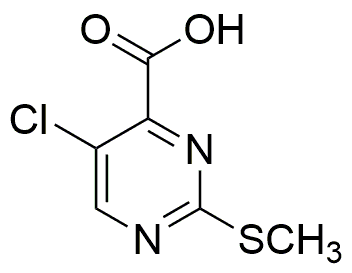5-Chloro-2-(methylthio)pyrimidine-4-carboxylic acid is widely utilized in research focused on:
- Agricultural Chemistry: This compound serves as a key intermediate in the synthesis of various agrochemicals, particularly herbicides. Its ability to inhibit specific plant enzymes makes it valuable for developing effective weed control solutions.
- Pharmaceutical Development: It is used in the synthesis of pharmaceuticals, especially in creating compounds that target specific biological pathways. Researchers appreciate its role in developing potential treatments for various diseases.
- Biochemical Research: The compound is utilized in studies exploring metabolic pathways and enzyme interactions. Its unique structure allows scientists to investigate the effects of sulfur-containing compounds in biological systems.
- Material Science: This chemical is explored in the development of novel materials, including polymers and coatings. Its properties can enhance the performance and durability of materials used in various applications.
- Analytical Chemistry: It is employed as a reference standard in analytical methods, aiding in the identification and quantification of similar compounds in complex mixtures, which is crucial for quality control in various industries.
Informations générales
Propriétés
Sécurité et réglementation
Applications
5-Chloro-2-(methylthio)pyrimidine-4-carboxylic acid is widely utilized in research focused on:
- Agricultural Chemistry: This compound serves as a key intermediate in the synthesis of various agrochemicals, particularly herbicides. Its ability to inhibit specific plant enzymes makes it valuable for developing effective weed control solutions.
- Pharmaceutical Development: It is used in the synthesis of pharmaceuticals, especially in creating compounds that target specific biological pathways. Researchers appreciate its role in developing potential treatments for various diseases.
- Biochemical Research: The compound is utilized in studies exploring metabolic pathways and enzyme interactions. Its unique structure allows scientists to investigate the effects of sulfur-containing compounds in biological systems.
- Material Science: This chemical is explored in the development of novel materials, including polymers and coatings. Its properties can enhance the performance and durability of materials used in various applications.
- Analytical Chemistry: It is employed as a reference standard in analytical methods, aiding in the identification and quantification of similar compounds in complex mixtures, which is crucial for quality control in various industries.
Documents
Fiches de données de sécurité (FDS)
La FDS fournit des informations de sécurité complètes sur la manipulation, le stockage et l’élimination du produit.
Spécifications du produit (PS)
Le PS fournit une description complète des propriétés du produit, notamment sa composition chimique, son état physique, sa pureté et les exigences de stockage. Il détaille également les plages de qualité acceptables et les applications prévues du produit.
Certificats d'analyse (COA)
Recherchez des certificats d'analyse (COA) en saisissant le numéro de lot du produit. Les numéros de lot et de lot se trouvent sur l'étiquette d'un produit, après les mots « Lot » ou « Lot de fabrication ».
Numéro de catalogue
Numéro de lot/série
Certificats d'origine (COO)
Ce certificat d'exploitation confirme le pays dans lequel le produit a été fabriqué, et détaille également les matériaux et composants utilisés et s'il est issu de sources naturelles, synthétiques ou autres sources spécifiques. Ce certificat peut être requis pour les douanes, le commerce et la conformité réglementaire.
Numéro de catalogue
Numéro de lot/série
Fiches de données de sécurité (FDS)
La FDS fournit des informations de sécurité complètes sur la manipulation, le stockage et l’élimination du produit.
DownloadSpécifications du produit (PS)
Le PS fournit une description complète des propriétés du produit, notamment sa composition chimique, son état physique, sa pureté et les exigences de stockage. Il détaille également les plages de qualité acceptables et les applications prévues du produit.
DownloadCertificats d'analyse (COA)
Recherchez des certificats d'analyse (COA) en saisissant le numéro de lot du produit. Les numéros de lot et de lot se trouvent sur l'étiquette d'un produit, après les mots « Lot » ou « Lot de fabrication ».
Numéro de catalogue
Numéro de lot/série
Certificats d'origine (COO)
Ce certificat d'exploitation confirme le pays dans lequel le produit a été fabriqué, et détaille également les matériaux et composants utilisés et s'il est issu de sources naturelles, synthétiques ou autres sources spécifiques. Ce certificat peut être requis pour les douanes, le commerce et la conformité réglementaire.


